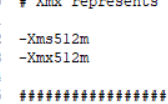1为什么要使用ElasticSearch
简单好用底层封装了Lucene以及支持其他语言的使用,操作简单,支持分布式实时搜索引擎,扩展服务器处理PB级别非结构化数据及结构化数据
2安装
ES服务只依赖于JDK,推荐使用JDK1.7+。
官方下载地址:https://www.elastic.co/downloads/elasticsearch
3修改
可以修改配置文件中的conf中的jvm.options文件

为你电脑内存分配的大小,但是不能够太小,如果电脑不太行就512m可以了
找到bin中的

点击即可
只能够使用Restful风格
Restful的典型特征:
² Server提供的RESTful API中,URL中只使用名词来指定资源。
“资源”是REST架构或者说整个网络处理的核心。比如:
GET http://api.itsource.cn/emp/323: 获取323号员工的基本资料;
GET http://api.itsource.cn/emps: 获取源码时代所有员工资料列表;
² REST 是面向资源的,这个概念非常重要,而资源是通过 URI 进行暴露
URI 的设计只要负责把资源通过合理方式暴露出来就可以了。对资源的操作与它无关,所以REST 通过 URI 暴露资源时,会强调不要在 URI 中出现动词。
比如:左边是错误的设计,而右边是正确的
GET /rest/api/getDogs -> GET /rest/api/dogs 获取所有小狗狗
GET /rest/api/getDogById?id=1 -> GET /rest/api/dog/1 获取所有小狗狗
GET /rest/api/addDogs -> POST /rest/api/dogs 添加一个小狗狗
POST /rest/api/editDogs/12 -> PUT /rest/api/dogs/12 修改一个小狗狗
POST /rest/api/deleteDogs/12 ->DELETE /rest/api/dogs/12 删除一个小狗
左边的这种设计,很明显不符合REST风格,URI 只负责准确无误的暴露资源,而 getDogs/addDogs...已经包含了对资源的操作,这是不对的。相反右边却满足了,它的操作是使用标准的HTTP动词来体现。
③ 用HTTP协议里的动词来实现资源的添加,修改,删除等操作。
即通过HTTP动词来实现资源的状态扭转:
GET 用来获取资源,
POST 用来新建资源(也可以用于更新资源),
PUT 用来更新资源,
DELETE 用来删除资源。
比如:
GET http://api.itsource.cn/emp/323
POST http://api.itsource.cn/emp/232: 修改一个员工
PUT http://api.itsource.cn/emp: 添加员工资料
DELETE http://api.itsource.cn/emp/323: 删除323号员工
2 Kibana5
1安装
:https://www.elastic.co/downloads/kibana
可视化界面找到bin中的bat文件和ES的使用一样的点击就可以了,不过这里不能狗点击ES的文件,而且必须需要先打开ES并成功运行
访问localhost:5601即可到

点击Dev Tools文件
2.简单的使用crud

GET _search #添加员工如果没有就添加如果有就修改 PUT /pethome/employee/1 { "id":"1", "username":"jiedada", "password":"123456" } #获取员工对象 GET /pethome/employee/1 #修改员工对象 PUT /pethome/employee/1 { "id":"1", "username":"jiedada", "password":"123456", "sex":true } #修改部分内容 POST /pethome/employee/1/_update { "doc": { "id":"1", "username":"jie" } } #删除内容 DELETE /pethome/employee/1 #批量操作 POST _bulk { "delete": { "_index": "itsource", "_type": "employee", "_id": "123" }} { "create": { "_index": "itsource", "_type": "blog", "_id": "123" }} { "title": "我发布的博客" } { "index": { "_index": "itsource", "_type": "blog" }} { "title": "我的第二博客" } #删除全部 DELETE _all GET /itsource/blog/123 #方式1:GET _mget获得不同index中的多个 GET _mget { "docs" : [ { "_index" : "itsource", "_type" : "blog", "_id" : 2 }, { "_index" : "itsource", "_type" : "employee", "_id" : 1, "_source": "email,age" } ] } #查询多个 GET itsource/blog/_mget { "ids" : [ "2", "1" ] } #空搜索 GET _search #分页查询size分页的大小,from从多少条开始(从0开始) GET _search?size=2&from=0 #分页查询size分页的大小,from从多少条开始(从0开始) GET _search?size=2&from=0
3.DSL查询与过滤

#DSL查询与过滤 PUT /pethome/employee/8 { "id":"1", "username":"jieaa", "password":"123456", "age":16 } #多查询的另一种方式match的意思就是分词查询还可以使用term不分词 GET pethome/employee/_search { "query" : { "term" : { "username" : "jie" } } } #通配符查询 GET pethome/employee/_search { "query": { "wildcard" : { "name" : "*j*" } } } #完整的查询带有分页排序_source我们需要的数据type,sort排序方式 GET pethome/employee/_search { "query": { "match": { "username": "jie" } }, "from": 0, "size": 5, "_source": ["username", "age", "password"], "sort": {"age": "desc"} } #查询和过滤bool表示先过滤后查询,term表示不分词精确匹配 GET pethome/employee/_search { "query": { "bool": { "must": [ { "match": { "username": "jie" } } ], "filter": { "term": { "password": "123456" } } } }, "from": 0, "size": 5, "_source": ["username", "age", "password"], "sort": {"age": "desc"} } #查询和过滤bool表示先过滤后查询,range表示范围过滤gt表示大于gte大于等于lt小于lte表示小于等于 GET pethome/employee/_search { "query": { "bool": { "must": [ { "match": { "username": "jie" } } ], "filter": { "range": { "age":{ "lt":15 } } } } }, "from": 0, "size": 5, "_source": ["username", "age", "password"], "sort": {"age": "desc"} }
4.简单映射

#简单映射properties属性值analyzer分词器类型search_analyzer查询使用的分词器type文本text分词并且保存到数据区 POST pethome/employee/_mapping { "employee":{ "properties":{ "id":{ "type":"text" }, "username":{ "type": "text", "analyzer": "ik_smart", "search_analyzer":"ik_smart" } } } }
